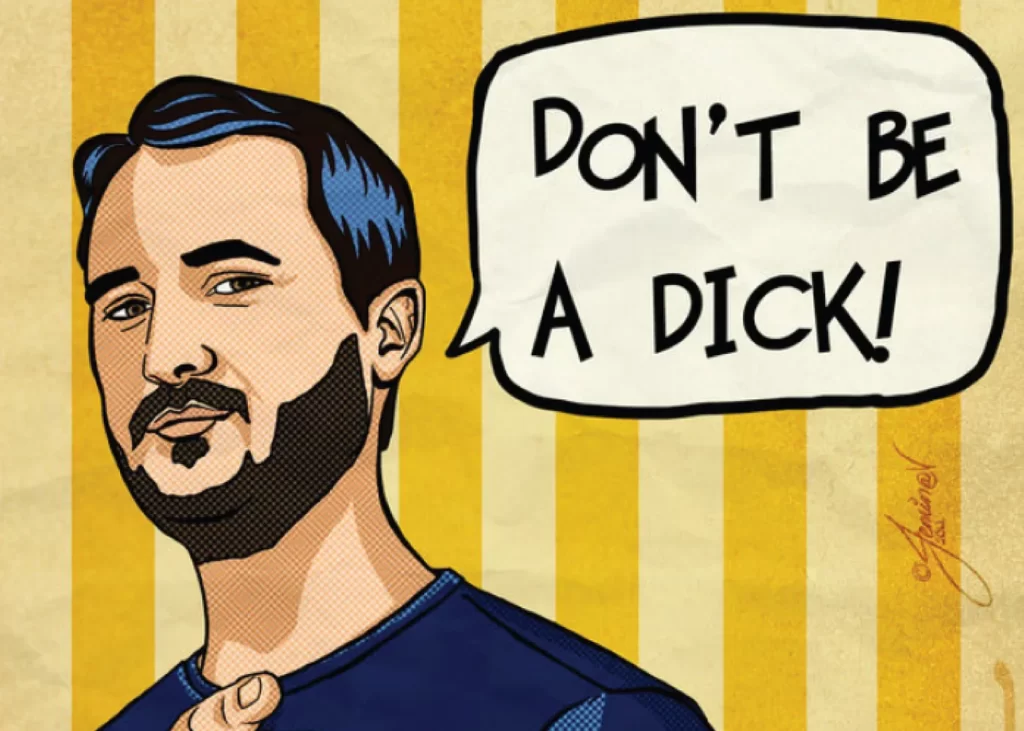There is a fundamental aspect of aikido that is seldom discussed and often ignored. Uke should attack the nage. This is something that rarely happens in aikido. If you look at the countless hours of online footage you’ll realise that most uke do not attack the nage. Intriguingly, Tomiki aikido represents an almost universal departure from this. An uke from the shodokan style definitely attacks the nage. The rest of us though, we have work to do.
The Job of Uke
There are several important aspects to uke’s job. The most obvious is that they should attack the nage. This may seem so obvious that it doesn’t need said, yet most uke do not do it. There is a tendency to make a half-hearted attack, then run around in a circle until it’s time to fall over.
This is the result of an intense focus on harmony within the art. The problem is that with this focus, aikido lost its danger. If there is no attack, the nage is in no danger. If there is no danger, there is no aikido.

Unpopular Opinion Time
There are several things at work here, and whether you agree will depend on how you train, and what you want from it. The first thing is that aikido is a martial art. To learn its nuances, philosophy, spirit, and techniques, it needs to be trained as a functional martial art. The majority of aikidoka today do not train like this.
This means that uke needs to attack the nage. There has to be an intent to cause some damage. This does not mean that uke tries to wipe nage out. A better way to think of it is to consider every technique as light sparring. The only prescribed thing about a partner practice in aikido is the uke’s initial attack.
Aikidoka are very fond of saying that there are no rules in aikido, it’s time to apply that concept to the training.
Uke’s Job Description
There are certain roles that an uke has to fulfil to be a productive training partner. The first is to attack the nage in the way initially called for. That could be shomen uchi, tsuki, ryote dori, etc. Each attack has a slightly different goal, so providing the correct attack is important.
It is also vital to realise that the correct initial attack is the only thing uke must do. After that first attack, uke is technically free to move as they like. They are not required to fall over unless nage makes them. They do not have to follow the ideal motion of the technique to its conclusion. In fact, uke should follow the actual motion of the technique, not the ideal.
Many people say that uke should help nage, this is true, but not in the way most people do it. Nage is trying to do aikido. Uke should help them do that not by compliance, but by resistance. They should force nage to do aikido by removing the other options.

Uke Is Supposed To Resist
After the initial attack, uke should constantly move into the most martially sensible position to attack the nage without disengaging. After uke’s attack the nage has entered, bringing them close to the uke. The uke should be unable to disengage without getting hit by nage, so they have to maintain their contact. Rule #1 – ‘don’t get hit’ applies to both uke and nage.
Uke should be attempting to regain the line of attack and nage should be attempting to stay off it. This means uke is constantly pressuring nage. This pressure will force nage to continue performing an aikido technique. If that pressure lets up, then there is no reason for nage to continue the technique. Instead, a hole has appeared in uke’s position, and nage should immediately hit them.
There is a dynamic here that many aikidoka do not pay attention to. Uke is always on the attack, nage is also always on the attack. The difference is that nage is in control. They are driving uke who should be trying to take control again.
The true work of uke happens after the initial attack, and before the final fall.
What Happens When Uke Resists?
The first thing is that everything tightens up. Nage’s technique improves, as does uke’s ukemi. The whole thing becomes a lot more martial and functional. When uke resists, nage has to work.
It will also resuscitate the dead arm. Don’t pretend you don’t know what this is. It’s the non-attacking arm, the one that just hangs there. This arm should be alive, ready to take advantage of a gap. Resistance to nage will bring that arm back to life and make it useful.
All this will make the uke become an active participant and not just a body waiting to roll.
The true work of uke happens after the initial attack, and before the final fall.
Wheaton’s Law
No matter what happens it is critical that uke obey’s Wheaton’s Law. “Don’t be a dick.”
The level of resistance must scale to the nage’s ability. This is the most difficult aspect of ukemi. Pitching the interaction so that when uke attacks the nage, they are pushing the limit of what nage can do. Ideally, aikidoka should fail their technique 25% of the time. That includes the sensei.
A major part of uke’s job is to force that failure, but anybody can force a technique to fail. It’s easy to do that, especially if you know what the technique is. The real skill is to force constructive failure. When the technique fails, it should be in a way that helps the nage to learn and improve.

What Does This Look Like For Uke?
You could write an entire book on how to attack the nage, here though, are a few fundamental concepts to consider.
Follow Through
Whether striking or grabbing there must be follow through. For example, tsuki does not target the front of the body, it targets 5cm past the spinal column. Without follow through, there is no possibility of damage, however slight. Without the danger, there is no martial art.
It’s not uncommon for aikidoka to state that uke provides the energy for the nage. If that is true, then without follow through, there is no energy to work with.
Uke must follow through on both grabs and strikes.
Static Is Not Stationary
When working from a static position, e.g. shomen uchi, this does not mean stationary. A stationary position is where you have stopped moving. A static position is a snapshot in time. Uke should view the attack as frozen, not stopped. All the momentum is still there.
In shomen uchi, this means that the uke should either be forcing their arm down, or lifting it away from the nage. Regardless, there is movement implied in the attack. Uke is still providing energy to nage.

Stop Waiting
When uke attacks the nage, there is no sudden time vortex between the initial attack and falling over. Uke is active throughout the entire technique. They should be paying attention to everything nage does, ready to exploit a weakness.
Uke should not half-heartedly attack, and then simply wait to fall over. There is a lot of work for uke to do, and it requires concentration, effort, and skill.
Strikes Hit, Grabs Control
This seems obvious but it slips past many people. When the attack is a strike, it should hit the uke if they don’t move. It doesn’t have to be hard, but the nage should know they were hit.
Similarly, if uke grabs nage, there should be an element of control. Different grabs seek to control in different ways, but that’s what uke should be attempting to do. It might be to move a limb to create an opening for a second attack, it might be to break the nage’s structure. Regardless, a grab should have some form of control imposed on the nage.

Always Expect To Attack Twice
Uke should assume that they will not just attack the nage once. They should view every attack as the opening step in a series. Grabs create openings, strikes soften up for the next one. There is never just a single attack. Adopting this mindset will generate an aliveness in the ukemi. Uke will start to actively look for an opening to attack into. This will, in turn, create resistance and pressure on the nage and force them to improve their technique.
It’s Not All Uke’s Way
Remember though, this is a two-way street. Just as uke should pressure and try to hit nage, nage can hit back. The techniques of aikido make little martial sense unless you are forced to do them. When uke attacks the nage, they force them to do aikido. If the uke stops forcing that, then nage should hit them.
If uke does not move into a martially sensible position, if they do not maintain pressure on nage, they are in danger. It is likely that they have moved into a position where they can be hurt. This presents nage with two choices. Continue performing the technique, or hit the uke. The aikido way, would be to continue the technique, and possibly resolve things peacefully. Hitting the uke is the martially sensible thing to do.
There Is No Break Time On The Mats
There are two sides to training in aikido. Waza, and ukemi. It’s often said that ukemi is as important as the waza. If that’s true, then it’s time we started paying it as much attention and treating it with the importance it deserves.
Don’t view ukemi as break time. Uke’s job is to attack the nage and force them into a higher level of technique. Without controlled, resistant ukemi, there is no aikido.
If you can afford it, and would like to help out,
consider donating some brain fuel!
Also, if you enjoyed this post you can find further insights in this book.